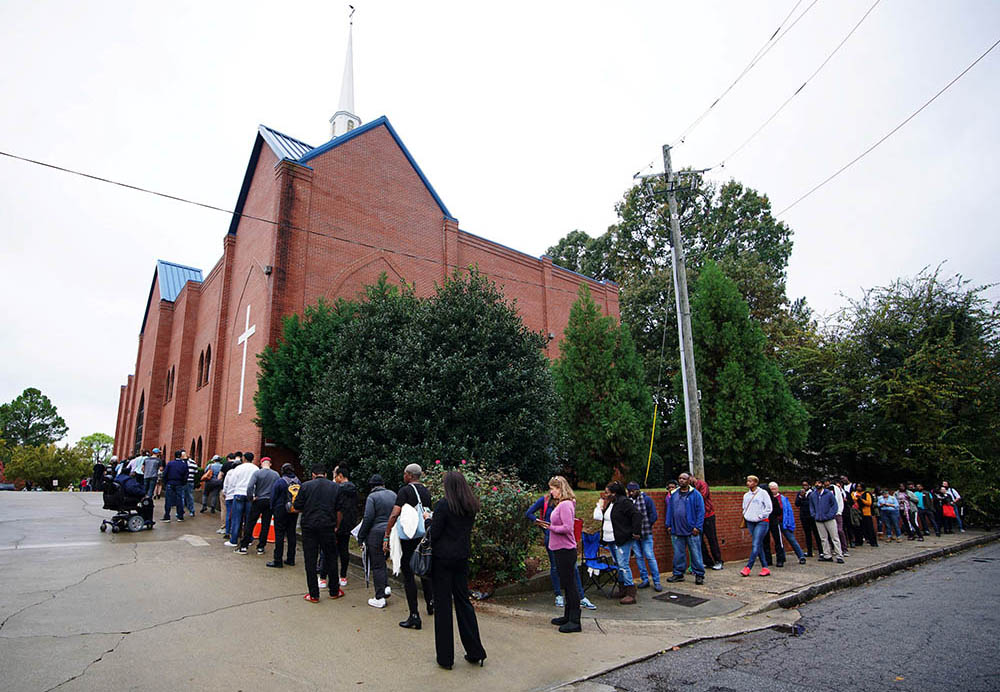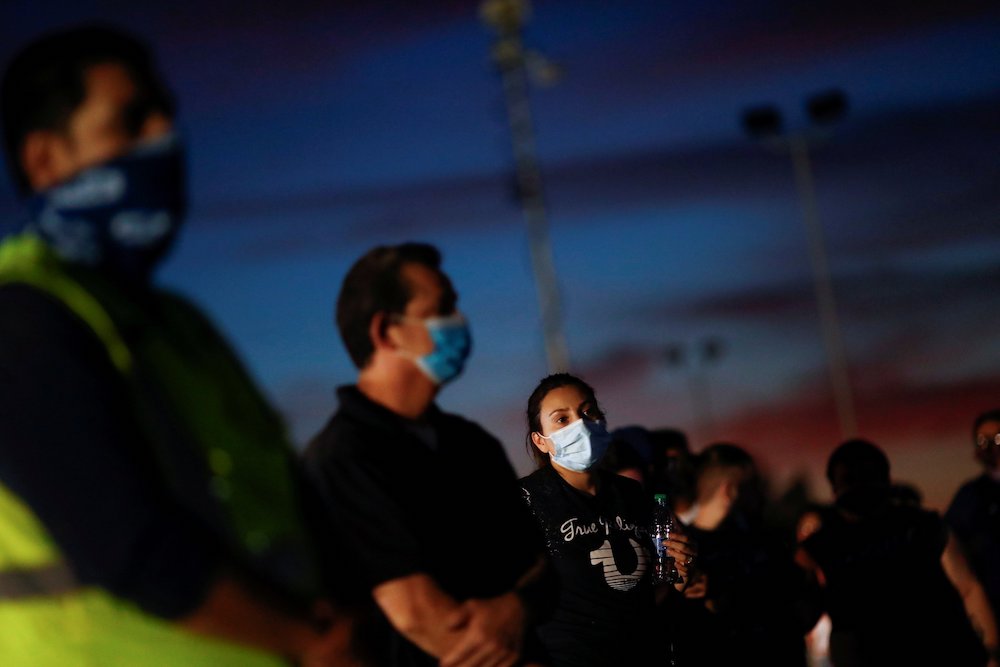
A line of voters wraps around Our Lady of Lourdes Catholic Church in Atlanta during midterm elections Nov. 6, 2018. (CNS/Reuters/Lawrence Bryant)
As I discussed in Monday's column, the midterm primary season will not only shape the November election, but also tell us about the relative power dynamics within each of the two parties. While the dynamics are different in each party, religion is likely to play a role in determining the outcomes in both the Democratic and Republican races.
For Catholics, the Democratic contests are the more interesting because the divide within the party is more explicitly ideological. The New York Times' Alexander Burns, in a recent tweet about his new book about the 2020 election, co-authored with Jonathan Martin, excerpted a section in which House Speaker Nancy Pelosi analyzed why the Democrats almost lost their majority in the House of Representatives:
In a few strictly confidential conversations she [Pelosi] pointed a finger leftward. Pelosi told one senior lawmaker that Democrats had alienated Asian and Hispanic immigrants with loose talk of socialism. In some of the same communities, the Italian Catholic speaker said, Democrats had not been careful enough about the way they spoke about abortion among new Americans who were devout people of faith.
This disconnect with immigrant voters and their values accounted in large part for the most remarkable fact about the 2020 election: Donald Trump did better among Latinos than he had done in 2016, and also among Black voters in some states.
Pelosi's observation echoes the theory put forward last year by Democratic data guru David Shor. "The Democratic Party was trapped in an echo chamber of Twitter activists and woke staff members," as Ezra Klein summed up Shor's thesis in The New York Times. "It had lost touch with the working-class voters of all races that it needs to win elections, and even progressive institutions dedicated to data analysis were refusing to face the hard facts of public opinion and electoral geography."
Ian Ward, at Politico, also used Shor's analysis to look at "the Democrats' privileged college-kid problem."
I asked Luis Fraga, a politics professor at the University of Notre Dame and director of the school's Institute for Latino Studies, about Pelosi's assertion. Fraga told me that "we don't have the polling to make that determination."
But he added, "Latinos tend to poll more conservative on this issue [abortion] compared to liberal Democrats, but it is rarely the most important issue."

Latino voters in the Maryvale neighborhood of Phoenix line up at a polling station to vote in the presidential election Nov. 3, 2020. (CNS/Reuters/Edgard Garrido)
"For some evangelical Latinos and some traditionalist Latino Catholics, it may be determinative, but they are a minority of the Latino vote," Fraga said.
He noted, too, that in any election, a Republican is likely to get at least 25% of the Latino vote, that the demographic has never been as monolithic as one might think listening to talking heads on television breezily pontificate on "the Latino vote."
Fraga also noted that the disconnect between young activists and the voters they seek to reach can be "a very significant problem." For example, the website at the voter mobilization group Voto Latino repeatedly uses the term "Latinx," despite the fact that the Pew Research Center found most Latinos are unfamiliar with the term and do not use it.
"The best way to contact a Latino voter is with someone who is a co-ethnic and who refers to the demographic in the same way they do in the local community," Fraga explained. In some areas, "Hispanic" is more common, and in others "Latino" is typical. Only among academics and students is "Latinx" even used.
Democrats need to figure this all out, and soon. According the projections from the nonpartisan National Association of Latino Elected and Appointed Officials Education Fund (NALEO), "At least 11.6 million Latinos will cast ballots in 2022, a 71.4 percent increase in the number of Latino voters from 2014." That increase is expected to be in key battleground states where both parties have recognized the need to invest in voter outreach to the Latino community. "Latino voter turnout in 2022 is projected to increase from 2018 in the key battleground states Arizona (9.6 percent), Colorado (8.9 percent), and Nevada (5.8 percent)," the group said.
The Senate contests in Arizona and Nevada are rated as tossups at both Politico and the Cook Political Report.
NALEO's projections noted that in many other states with large Latino populations, such as California, Florida and New York, Latino turnout is expected to mirror the midterms in 2018, which was itself a year of record-breaking turnout. There might even be a drop-off from 2018 in Texas and New Mexico, according to their projections.
A similar concern to speak the same cultural language is at the heart of the other demographic group Democrats need to win back: white working-class voters.
'It is not clear how many Catholic voters bring their Catholic identity into the voting booth.'
—John White
In the key swing state of Pennsylvania, Joe Biden clawed the state back into the Democratic column after Hillary Clinton lost it in 2016. He did so in part by outperforming Clinton in those ethnic, Catholic enclaves like Luzerne County and his native Lackawanna County where white working-class voters predominate.
According to John White, politics professor at the Catholic University of America, one of the ways Biden won was "by personalizing the election and tying it to his own cultural values, values he shared with the electorate. And, for Biden, his Catholicism is such an integral part of that. It works because it is real."
White added that while Democrats will not win in rural areas with more conservative cultural norms, "you still need to show up and make your case."
This year, U.S. Rep. Tim Ryan is running for the Senate in Ohio as a kind of young Joe Biden. He, too, is campaigning in areas where Democrats have struggled to attract working-class voters and in rural precincts of the state. Being a Catholic is a big part of Ryan's identity as well.
"Being Catholic, that Catholic identity, Ryan shares that with Biden," said White. "But it's complicated. It is not clear how many Catholic voters bring their Catholic identity into the voting booth. That sense of identity can be accentuated if the bishops enter the fray, but I suspect they won't be getting too involved."
The lesson of last year for the Catholic hierarchy was that any effort to go after politicians will divide the conference and worry officials in Rome.
For Republicans, fealty to Trump has become the defining characteristic of the primary contests, and candidates have been obsequious in courting the former president's endorsement. Over the weekend, it became clear that Trump has shaped the race but he might not be able to determine the outcome. He endorsed Ohio Senate candidate J.D. Vance and went to the Buckeye state for a rally with the author-turned-politician, but Vance received a decidedly mixed reception from the crowd.
Advertisement
It will be interesting to see the degree to which Trump's high approval ratings among evangelical Christians are transferable to candidates he has endorsed. Some evangelical churches are joining the former president in continuing to question the results of the 2020 election, a strategy that seems likely to backfire in November with swing voters more concerned about inflation and the war in Ukraine. But midterm elections are low-turnout affairs, and midterm primaries even more so. Evangelical Christians have strong networks that might prove decisive in selecting which GOP candidates will move on to November's elections.
"In the case of the Religious Right, some of the same processes that have driven them toward more radical right-wing political positions and tactics have also driven higher voter engagement," Ruth Braunstein, associate professor of sociology at the University of Connecticut, told me in an email interview. "Namely, the perception that white Christians are being unjustly persecuted by the broader society, especially by liberals and secularists. This 'persecution complex,' as it is sometimes called, has been a tremendous motivator to engage in politics. White evangelicals vote at very high rates because they see elections as a way of defending their 'religious freedom,' their 'way of life,' and even 'their country' from attack by these hostile groups."
Braunstein does not see an equivalent dynamic on the secular left. Especially among secular young people, the so-called "nones," the relationship of religion and politics is very complicated, and even viewing the "nones" as secular is problematic.
"It is not clear that 'Nones'' shared distaste for the Religious Right is enough to mobilize this group as a bloc. Even if they are highly engaged politically, they are an internally diverse bunch, in their orientations toward both religion and politics," Braunstein noted. "Moreover, we should keep in mind that their way of reacting against the Religious Right was disaffiliating from organized religion. For some, this may be part of a broader wave of rising partisanship in which increasingly salient partisan identity overtakes other forms of identity and belonging. For others, religious disaffiliation may reflect a more general anti-institutional sentiment, which could extend to a rejection of partisan labels as well."
Braunstein added: "So even though the 'Nones' lean liberal, it is unlikely they will be nearly as unified in their partisan behavior as, say, white evangelicals."
We can expect mainstream commentary to reduce all these complexities to slogans. One thing is clear: The political parties need to pay attention to the nuances of religious affiliation and imagination, how those attachments and ideas overlap with demographic and class issues, and how different kinds of religious voters approach politics and evaluate candidates.
In low-turnout midterm elections, highly motivated voters are key, and few things in life motivate people more concretely than religion. In a couple of months, the two parties will have decided what kind of party they wish to be, and religion will play a significant, if enormously complicated, role in that decision.




